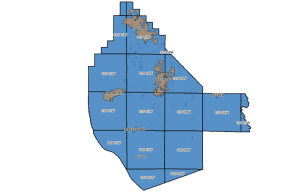PDR school story is unique
This area of Southwestern Illinois has a long history for which its residents are very proud, with locals possessing a strong appreciation for the various historic monuments and buildings in the community as well as the traditions which their ancestors began.
One especially strange quirk of local history can be found in Prairie du Rocher, where a tradition with roots stemming back to the 18th century continues to make the village’s school system among the most unique in Illinois.
Alongside Prairie du Rocher School District #134, which consists entirely of the community’s elementary school, Rocher is also served by Chester Non-High School District #122.
Per the Monroe-Randolph Regional Office of Education’s website, students living within this district – which mirrors District #134 – are able to attend the high school of their parents’ choice upon graduating from eighth grade.
The non-high school district, like any other school district, levies taxes to provide tuition for Prairie du Rocher students, also – assuming funding is available – providing transportation to high schools in contiguous districts.
These districts include Valmeyer to the northwest, Waterloo to the north and Red Bud, which covers the eastern edge of the village’s school district limits.
Thus, high school students in Rocher have the option of attending any public school in the state, though naturally, the trend is for students to attend high school in one of the aforementioned districts, with many headed to Red Bud.
The establishment of the non-high school district dates back over a century, though its roots extend even further.
One local authority on this district is previous Regional Superintendent Dr. Marc Kiehna, who wrote his dissertation on the district.
Offering a thorough overview of the district’s background, history and modern impact, Kiehna noted the historical significance of Rocher and Kaskaskia Island as well as how important the area was for French colonialism.
Early education in the area was heavily influenced by the Catholic Church as priests would not only teach catechism but also how to read and write.
As local education continued, the French sought a way to pay for it. They divided the area into arpents – a French unit of measurement slightly smaller than an acre – with each strip of land from the bluff to the river paying its share of tax into what was known as the Commons Fund.
While this specific tax no longer exists, Kiehna said the funds accrued by it still play a role in the area’s education funding.
“As that all evolved, there needed to be a way to fund education for children, both on Kaskaskia Island and in Prairie du Rocher,” Kiehna said. “So the French came up with an idea to fund the schools on the island, and it was called the Commons Fund. The Commons Fund still exists today. Funds are in our local bank, and there’s a commons board that manages the Commons Fund which started way, way back with King Louis the XV of France.”
Jumping forward from the era of French colonialism to shortly after the American Civil War, Kiehna spoke about the continued development and organization of education in the state and in the region, with the establishment of county school superintendents in Illinois to help manage the funding and provision of teachers for the numerous one-room schoolhouses.
Further progress in the realm of organization continued in and beyond the 1890s.
“The State of Illinois felt it was important, if we were going to move toward public schools, that there be some type of a, I guess a rule of law that said what these children should learn when they’re in their schoolhouses,” Kiehna said.
Around this time was the start of township high schools, with the first in this area opening in Sparta.
Kiehna described how students would generally be educated through the eighth grade somewhat locally before being sent to high school – which often varied from two-year to three-year schools.
Some communities were large enough to warrant the creation of a four-year high school, but the length and focus of a school was generally determined by the needs of the community it was in. Additionally, some students opted to finish a full four-year education by studying more at other schools.
All this development then led to the legislature imposing a new law necessitating high schools and non-high school districts.
“It required all properties not included in a township high school district, community high school district or district maintaining a recognized four-year high school be organized into a non-high school district for the purposes of levying a tax to pay the tuition of all eighth grade graduates residing in the non-high school district,” Kiehna said.
Kiehna further explained the taxes levied were based on per capita cost to educate a high school student.
Rocher’s district was named the Chester Non-High School District as this was the county seat where Rocher-levied taxes were sent to pay the tuition of a Rocher student attending Sparta or another high school.
Kiehna discussed how this arrangement was especially sensible in 1917 when paved roads, buses and cars weren’t exactly common conveniences, though this was quick to change in the decades that followed.
“Around 1940-ish, a lot of things were happening,” Kiehna said. “We started having school buses, and we started having roads that were paved. It made more sense to group kids together both fiscally and educationally, to put more kids together in a particular school.”
In the late 1930s, more and more communities went from having a collection of one-room schoolhouses to being districts. Kiehna noted this was precisely the change that made communities like Waterloo or Red Bud into unit districts.
For Rocher, this all came to a head in 1951 with another law mandating high school consolidation, with no property in the state allowed to support non-high school districts.
Rocher, however, was allowed an exception as any consolidation with a neighboring school district would likely have seen the much-loved elementary school close.
Thus, the Chester Non-High School District continues to this day.
Kiehna spoke further about how the district exists today, with residents within the district paying roughly the same as individuals in a unit district. Rocher tax bill revenue is effectively just split between both the elementary and non-high school districts.
The district continues to have three elected board members overseeing it, with the regional superintendent serving as the secretary ex officio, acting as a typical superintendent would by virtue of his position within the Regional Office of Education.
Funds are still managed by the regional superintendent and the board, with the district paying for tuition to the school of the student’s parent’s choosing.
“It’s like running a school without a building,” Kiehna said. “There’s no school nurse, there’s no basketball team or anything like that. It’s like running a school without a building.”
Kiehna reiterated the significance of the district and spoke further about Rocher’s history in general, with its place as one of the earliest settlements in Illinois, the rich French history, the use of arpents, the Commons Fund investments which continue today and all the developments and changes that the community has seen through the centuries.
“It exists today because the people of Prairie du Rocher don’t want to lose their elementary school,” Kiehna said. “If Chester Non-High went away, if the powers that be said, ‘We don’t wanna do this anymore. We want to pay one tax bill. We don’t want it to go to two different entities, et cetera. We don’t care about the rich history of Prairie du Rocher anymore or Kaskaskia Island anymore.’ If the non-high went away, there would have to be a decision made on where those students would attend school. It would just be like consolidating a school district.”






